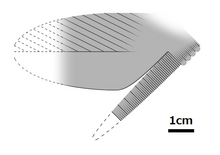| Cucumericrus Temporal range: Miaolingian–Middle Cambrian PreꞒ Ꞓ O S D C P T J K Pg N | |
|---|---|

| |
| Trunk appengae of Cucumericrus decoratus | |
| Scientific classification | |
| Domain: | Eukaryota |
| Kingdom: | Animalia |
| Stem group: | Arthropoda |
| Genus: | †Cucumericrus Hou, Bergstrom & Ahlberg, 1995 |
| Type species | |
| Cucumericrus decoratus Hou, Bergstrom & Ahlberg, 1995 | |
Cucumericrus ("cucumber-leg") is an extinct genus of stem-arthropod. The type and only species is Cucumericrus decoratus, with fossils discovered from the Maotianshan Shales of Yunnan, China.
Description
Cucumericrus known from a few poorly preserved specimens. Only fragments of trunk cuticle and corresponded appendages had been revealed, while important taxonomic features such as head structures are unknown. The trunk cuticle possess irregular wrinkles and may had been soft in life. Each of the trunk appendage compose of a dorsal flap-like element and a ventral stubby leg with unknown distal region, structurally comparable to the trunk appendages of gill lobopodians (dorsal flaps and ventral lobopods) and euarthropod biramous appendages (flap-like exopod and limb-like endopod). Anterior margin of the flap lined with ray-like structures, similar to the body flaps of some radiodonts. The legs have been interpreted as somewhere between annulated lobopod legs and segmented arthropod legs.
Taxonomic affinities
Cucumericrus was originally described as a radiodont alongside Parapeytoia, a genus with somewhat similar trunk appendages, but later revealed to be a megacheiran being misinterpreted as a leg-bearing radiodont at that time. The radiodont affinity of Cucumericrus remain questionable, since the presence of legs is unknown from any other radiodonts and no other radiodont key features (e.g. frontal appendages; oral cone; head sclerites) had been discovered. Only a few phylogenetic analysis including Cucumericrus, either resolving it in a polytomy between euarthropods and other radiodonts (alongside Caryosyntrips) or closer to euarthropods (as a basal deuteropod) than radiodonts.
See also
- Caryosyntrips, another stem-arthropod with similar uncertainties.
- Parapeytoia, a megacheiran once thought to be similarly leg-bearing radiodont.
- Erratus, a basal deuteropod with similar component of trunk appendages.
References
- ^ Xian-Guang, Hou; Bergström, Jan; Ahlberg, Per (1995-09-01). "Anomalocaris and other large animals in the lower Cambrian Chengjiang fauna of southwest China". GFF. 117 (3): 163–183. Bibcode:1995GFF...117..163X. doi:10.1080/11035899509546213. ISSN 1103-5897.
- ^ Allison C. Daley & Graham E. Budd (2010). "New anomalocaridid appendages from the Burgess Shale, Canada". Palaeontology. 53 (4): 721–738. Bibcode:2010Palgy..53..721D. doi:10.1111/j.1475-4983.2010.00955.x.
- ^ Xian-Guang, Hou; Siveter, David J.; Siveter, Derek J.; Aldridge, Richard J.; Pei-Yun, Cong; Gabbott, Sarah E.; Xiao-Ya, Ma; Purnell, Mark A.; Williams, Mark (2017-04-24). The Cambrian Fossils of Chengjiang, China: The Flowering of Early Animal Life. John Wiley & Sons. ISBN 978-1-118-89638-9.
- ^ Jan Bergström & Hou Xian-Guang (2003). "Arthropod origins" (PDF). Bulletin of Geosciences. 78 (4): 323–334.
- ^ Van Roy, Peter; Daley, Allison C.; Briggs, Derek E. G. (2015). "Anomalocaridid trunk limb homology revealed by a giant filter-feeder with paired flaps". Nature. 522 (7554): 77–80. Bibcode:2015Natur.522...77V. doi:10.1038/nature14256. ISSN 1476-4687. PMID 25762145. S2CID 205242881.
- Stein, Martin (2010). "A new arthropod from the Early Cambrian of North Greenland, with a 'great appendage'-like antennula: A NEW CAMBRIAN ARTHROPOD FROM GREENLAND". Zoological Journal of the Linnean Society. 158 (3): 477–500. doi:10.1111/j.1096-3642.2009.00562.x.
- Legg, David A.; Sutton, Mark D.; Edgecombe, Gregory D.; Caron, Jean-Bernard (2012-12-07). "Cambrian bivalved arthropod reveals origin of arthrodization". Proceedings of the Royal Society B: Biological Sciences. 279 (1748): 4699–4704. doi:10.1098/rspb.2012.1958. ISSN 0962-8452. PMC 3497099. PMID 23055069.
- Legg, David A.; Sutton, Mark D.; Edgecombe, Gregory D. (2013-09-30). "Arthropod fossil data increase congruence of morphological and molecular phylogenies". Nature Communications. 4 (1): 2485. doi:10.1038/ncomms3485. ISSN 2041-1723. PMID 24077329.
- Aria, Cédric; Zhao, Fangchen; Zeng, Han; Guo, Jin; Zhu, Maoyan (2020-01-08). "Fossils from South China redefine the ancestral euarthropod body plan". BMC Evolutionary Biology. 20 (1): 4. doi:10.1186/s12862-019-1560-7. ISSN 1471-2148. PMC 6950928. PMID 31914921.
- Van Roy, Peter; Daley, Allison C.; Briggs, Derek E. G. (2015). "Anomalocaridid trunk limb homology revealed by a giant filter-feeder with paired flaps". Nature. 522 (7554): 77–80. Bibcode:2015Natur.522...77V. doi:10.1038/nature14256. ISSN 1476-4687. PMID 25762145. S2CID 205242881.
- Liu, Jianni; Lerosey-Aubril, Rudy; Steiner, Michael; Dunlop, Jason A; Shu, Degan; Paterson, John R (2018-11-01). "Origin of raptorial feeding in juvenile euarthropods revealed by a Cambrian radiodontan". National Science Review. 5 (6): 863–869. doi:10.1093/nsr/nwy057. ISSN 2095-5138.
- McCall, Christian R. A. (2023-12-13). "A large pelagic lobopodian from the Cambrian Pioche Shale of Nevada". Journal of Paleontology. 97 (5): 1009–1024. doi:10.1017/jpa.2023.63. ISSN 0022-3360. S2CID 266292707.
| Radiodonta | ||||||||||||||||||
|---|---|---|---|---|---|---|---|---|---|---|---|---|---|---|---|---|---|---|
| ||||||||||||||||||
| ||||||||||||||||||
| Taxon identifiers | |
|---|---|
| Cucumericrus | |
This article related to a Cambrian animal is a stub. You can help Misplaced Pages by expanding it. |
